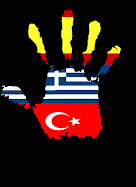
Sorolla en 1909 recibe el encargo de plasmar en una serie de lienzos destinados a decorar los salones de la Hispanic Society de Nueva York las diferentes regiones de España. Este trabajo le ocupa cinco años de su vida, sus últimos cinco años, ya que murió antes de ver instalados los murales en su lugar de destino. Su mirada no es exhaustiva. Recoge ideas y hace estudios y bocetos viajando por España pero no se plantea una representación fiel al mapa de España. Se deja llevar por su instinto de pintor y sigue sus impulsos. Sorolla “pinta con los ojos” y recoge esas impresiones sensoriales en su retina para luego trasladarlas a los cuadros. De hecho, en los catorce lienzos sólo aparecen retratadas nueve de las diecisiete regiones españolas y la atención que le dedica a cada una es desigual: el mural principal está dedicado a Castilla, cinco paneles están dedicados a Andalucía, dos a Valencia y uno respectivamente para Extremadura, Cataluña, Galicia, Aragón, Navarra y el País Vasco. Pero hay otras comunidades autónomas que no están representadas. La explicación es bien sencilla: su trabajo no es el de un científico, ni el de un geógrafo, sino el de un artista y por eso su criterio es subjetivo y su forma de organizar la materia es la yuxtaposición. Así, podemos decir que muchos de los cuadros son un testimonio de su preocupación por la luz: el aspecto brumoso del País Vasco frente al superabundante sol valenciano, la frescura con que se vende el pescado en Cataluña contrasta con la laboriosidad de los atuneros andaluces que trabajan bajo la opresión de un sol africano. Otros son prueba de su interés por reflejar el instante con precisión fotográfica, como “El baile” de Sevilla.
De la mano de estos cuadros de Sorolla podemos iniciar un recorrido por la geografía española. Os invitamos a hacerlo. Iremos visitando cada uno de estos paneles para conocer mejor nuestro país y para darlo a conocer a nuestros compañeros del Comenius. Os sorprenderá ver que mucho de lo que hoy somos como pueblo, de nuestra españolidad, está representado en esos cuadros.
De la mano de estos cuadros de Sorolla podemos iniciar un recorrido por la geografía española. Os invitamos a hacerlo. Iremos visitando cada uno de estos paneles para conocer mejor nuestro país y para darlo a conocer a nuestros compañeros del Comenius. Os sorprenderá ver que mucho de lo que hoy somos como pueblo, de nuestra españolidad, está representado en esos cuadros.
In 1909, Sorolla was entrusted a series of canvasses about the different regions of Spain to decorate the lounges at the Hispanic Society in New York. He spent five years in its production and died before they were installed at their final emplacement. His view is not completely precise. He collects different ideas and makes studios and outlines in his travels around Spain but he does not pretend an exact representation of a map of Spain. He lets his painter`s instinct free and follows its impulses. Sorolla paints “with his eyes” and gets those sensory impressions from his retina to reflect them later in his pictures. In fact, in the fourteen canvasses there only appear nine of the seventeen Spanish regions and his attention to them is unequal: the main wall display is dedicated to Castille, five others to Andalucia, two to Valencia and one to each of Extremadura, Catalonia, Galicia, Aragón, Navarra and the Basc country. But there are other communities which are nor reflected. The explanation is quite simple: his work is not that of the scientist or the geographer but that of the artist whose style is subtle and whose way of organising his work is juxtaposition. In this way we can say that most of the paintings are a testimony of his treatment of light: the gloomy aspect of the Basc country versus the powerful Valencian sun, the freshness of the fish selling in Catalonia contrasted with the ardous task of the Andalusian tunna fishers who work under the heat of an African sun. Others are the proof of his interest for reflecting the moment with photographical precision, as in “The Dance” in Seville.
From Sorolla pictures we can begin a trip around Spanish geography. We suggest you do it. We will visit each of these mural paintings to get to know our country better and to allow our partners in the project enjoy it. You will be surprised to check that most of what we are nowadays as a country, our identity, is present in these wall displays.






 Ahmet Çallioglu Çok Programli Lisesi (Aydin, Turkey)
Ahmet Çallioglu Çok Programli Lisesi (Aydin, Turkey)
 Primary School of Afxentio (Xanthi, Greece)
Primary School of Afxentio (Xanthi, Greece)
 I.E.S. Monastil
I.E.S. Monastil



0 comentarios:
Publicar un comentario